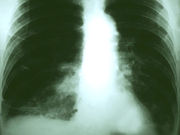Study found 21 percent went without therapy, even though it could boost survival
MONDAY, Jan. 23, 2017 (HealthDay News) — Many U.S. patients with late-stage non-small-cell lung cancer (NSCLC) do not receive treatments that could prolong their lives, according to a study published online Jan. 18 in the Journal of Thoracic Oncology.
Researchers at the University of California, Davis Comprehensive Cancer Center analyzed 1998 to 2012 data from the U.S. National Cancer Database. They found that 21 percent of patients with NSCLC did not undergo any treatment. Many of the untreated patients were women, elderly, minorities, low-income, and uninsured, according to the research team. The investigators found that the number of untreated patients with late-stage NSCLC even rose slightly during the study period.
Overall, survival rates of untreated patients with all stages of NSCLC were significantly lower than for those who received treatment, the researchers said. For example, median survival among patients with stage 3 disease was 16.5 months for those who received chemotherapy and radiation, but only 6.1 months for those who received no treatment. Median survival among patients with stage 4 disease was 9.3 months for those who received chemotherapy, but just 2.0 months for those who received no treatment.
“My hope is that this study will raise awareness among physicians and encourage them to reconsider fundamental decisions such as whether patients may be candidates for treatment or not,” first author Elizabeth David, M.D., an assistant professor of surgery at the University of California, Davis, said in a university news release. “While it’s not realistic to expect every patient to get treatment, we may be too easily deciding not to treat.”
Full Text
Copyright © 2017 HealthDay. All rights reserved.








